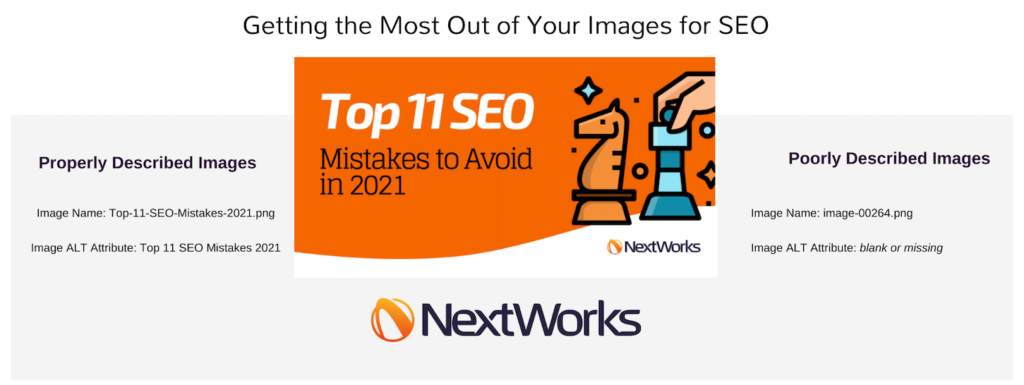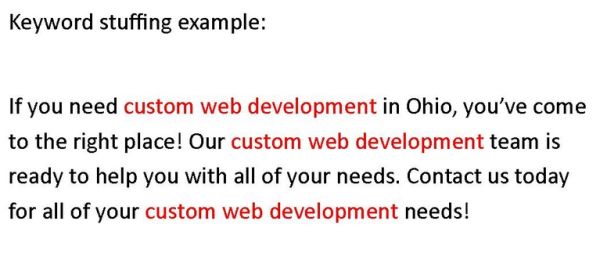Are You Guilty of These SEO Sins?
Habits can be hard to break. But, when it comes to search engine optimization it’s advisable to take a minute or two and check if you’re doing things right. Take a look at the list below and see if you’re guilty of these sinful SEO mistakes. If so, it’s not too late to wean yourself from these bad moves and save your ranking!
1. Poorly Described Images
Everyone uses at least a few images on their site. But, can search engines see them? And what about readers on slow or unstable connections? In these cases, a generically named image (“headerimage.jpg”) or one that’s lacking in alt-text might as well be invisible. Describe your images well, and you’ll be doing a massive favor for both visiting bots and your readers
Text is still the content most easily understood by search engines. Search engine spiders go through media content by looking for keyword phrases in prominent locations. As mentioned by Google’s Webmaster Guidelines. “Try to use text instead of images to display important names, content, or links.”

2. Keyword Stuffing
It’s tempting to try and get as many keywords as possible into your titles and headers. But, just because you can, doesn’t mean you should. Piling on irrelevant or awkward-sounding keywords and phrases might do more harm than good. Keep your titles readable and user-friendly, with a focus on just one or two well-chosen keywords.
While keyword stuffing could work in the short term, eventually you most likely will be caught, resulting in a harsh penalty or, in the worst case, a total Search Engine Results Page (SERP) removal. Google frowns on techniques such as keyword stuffing as they trade improving user experience for beating the algorithm. Maybe with the help of a thesaurus, you use synonyms for these keywords and only use those where they naturally fit in. Make sure your content is thoughtful and informative for the target audience that is reading it.
3. Website Dead Ends
Remember that not all visitors arrive at your site via the homepage. Make sure that it’s easy for them to find their way around wherever they land on your site. Whether you achieve this through a descriptive sidebar or clean and clear footer navigation doesn’t matter. Just be sure you don’t let new visitors get stuck in a dead-end.
Visitors flow through your website or they don’t. They keep moving, or they hit a dead end. Pages where the flow stops are where visitors are most likely to leave. Imagine yourself as a traffic cop and find places where the flow stops and add “detours”. If the detour was a subsequent action that creates another dead-end, re-route traffic and add another detour to keep things moving.
4. Irrelevant Anchor Text
We’ve probably fallen for the “click here” at one point or another. It’s more than likely that you’re not trying to optimize those exact words, so why make them the anchor text for a link? Instead, choose some relevant anchor text that gives readers (and bots) an idea of what they’ll find if and when they decide to click. Not only will this boost your keyword ranking, but your visitors will thank you as well.
Avoid anchor texts or backlinks that use words like “website”, “info”, “link” or phrases like “click here”, “read more”, “visit this page”, to link to another website. These provide the least amount of information about the page you are linking to. It’s impossible to know what you can expect to find on that backlink by simply looking at the text.

5. Focusing On Quantity of Links Over Quality
Google recommends a maximum of 100 links per webpage. This loose limit does not mean that they are going to punish anyone for having over a hundred links. Rather, Google is setting a standard that they believe to be the maximum amount of links present to keep the content relevant and meaningful.
You may want to take note that when a web page is jam-packed with links, it can look sketchy to visitors or be hard to read. This could drive people to leave the site, dropping the site’s search ranking. Keep in mind that every time a page includes an external link, that link is drawing a visitor away from the original site.
6. Creating Thin Content
If Google flagged your website with automatically generated content, thin affiliate pages, content from other sources, or doorway pages, then unfortunately Google has detected low-quality pages or shallow pages on your site – Thin content. Google dislikes low-quality or thin content, which violates their Webmaster Guidelines.
Length doesn’t automatically equal value. Sometimes keeping it short is still the way to go. There will be some sites that will advise you to meet a certain word count to avoid being flagged and penalized. But, there is really no rule on the specific number. Concise content is much more fascinating. If you have written all that needs to be written without all the wordiness and fluff, stop there. Substance, style, and social shareability are much more important than word count.
7. Duplicate Content
It may seem like posting content from another page on your site could help you rank on a specific keyword. But Google doesn’t like this and sees this practice as lazy and unethical. Copying content word-for-word that you found elsewhere on the internet is the same thing and that’s outright plagiarism. While duplicating text was a common practice back in the day, today, search engines penalize this approach. This can, of course, land you in legal trouble, and get you on Google’s bad side. It’s seen as spammy practice and is highly discouraged.
Using a plagiarism checker, like Copyscape, can help website owners check the originality of their new content, prevent duplicate content, and search for copies of existing content online. Publishing copied or stolen content on your site can not only ruin your reputation but can definitely ruin your search engine rankings.
8. Not Optimizing The Website For Core Web Vitals
Does your page load fast? Is it mobile-friendly? Google uses these as ranking factors for overall page experience. These metrics are called Core Web Vitals. These are used to make sure websites are providing a great user experience. But, then it’s nothing new. We’ve been doing these for a while now and should continue doing them. You always want someone to have a great experience when they come to a page on your website.
There is a need for speed. Optimize your site, continue to create great content, save yourself money by removing unneeded marketing tools. Make sure to compress images, use correct dimensions and sizes, and set height and width attributes to image tags. Instead of embedding large video files directly onto your website, use a 3rd party video hosting service like YouTube to serve videos to your visitors. Avoid using third-party tracking scripts that are not relevant to your business or your marketing. Don’t use more than 8 total custom font variants on your website. It may look nice, but it will slow your loading time. You should avoid ads, Pop-ups, promo banners, etc. Not only can they be annoying, but this will also cause a shift in your layout. Try and eliminate CSS and Javascript calls for pages that do not need them or only use them when needed.
9. Lack of Internal Links
There are also common mistakes when including internal links that you should watch out for. it’s natural to think about your top-performing pages and consider placing links to them in your content. This is a way to give them visibility and create additional traction. But make sure you don’t include internal links just for the sake of having them in an article if they don’t match the topic and focus of the piece. As with keyword stuffing, it’s important to not overdo internal linking. If the content and links seem unnatural, the work will not be appreciated by your target customers.
10. Skipping The Title Tags and Meta Descriptions
Title tags and meta descriptions are important elements of your website’s content and are important for SEO. It’s a big no-no to skip these. Title tags and meta descriptions are important because they’re typically the first encounter that a user has with your site when they perform a Google search. First impressions do count, especially with all that competition out there. Not providing well-written title tags and meta descriptions could mean that you are missing out on on-site visits and leads.
The title tag and the meta description tags should include keywords relevant to the content of the web page they describe. This helps search engines understand what the page is about and index your pages accordingly for relevant keywords or keyword phrases.
11. Ignoring Google E-A-T (Expertise, Authoritativeness, Trustworthiness)
Unless you’re a newbie to the search industry, you’ve probably heard about E-A-T. It’s been around since 2014, but it’s gradually become one of the most important elements of SEO. But, it’s also the most puzzling, even to industry experts.
E-A-T is one factor that Google uses to evaluate the overall quality of a web page. It values websites that demonstrate this. E-A-T is the basis of evaluation as to whether a website and its pages create real value for the user. It is determined by a combination of the creator, the content, and the website. It’s especially important for websites that publish “your money, your life” (YMYL) content, such as finances, health, safety, and/or happiness. YMYL sites are held to the highest possible E-A-T standards due to the subject matter and what it means for a user if that information is misrepresented.
E-A-T should be top of mind when developing your SEO strategy, especially If search engine optimization is critical for your digital marketing success. Tools like Semrush helps you follow and apply the E-A-T standards to your content. This enables you to have greater chances for organic search engine visibility and ranking success.
How to Optimize For Google’s E A T Algorithm
Guilty? Not Guilty?
If you’ve managed to steer clear of the above errors, congratulations! But don’t relax just yet. These are just a few of the multitude of possible SEO sins many sites are guilty of. You can use our tool to perform a free SEO audit. Though performing a full, in-depth SEO audit wold uncover all the SEO fixes your site needs. The language of SEO may seem overwhelming. But, you can count on NextWorks.io to help you with your digital strategy or customization services to help enhance your brand and bottom line.
So, repent those SEO sins today and raise your site rankings to the heavens.
